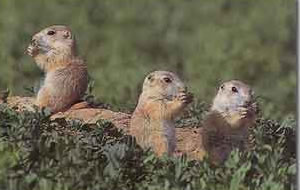|
March of the Prairie Dogs
One Sunday afternoon, after completing a lecture about
communicating with animals, I was approached by a college
professor who asked if I might be able to help him save
a colony of approximately fifty prairie dogs who were going
to be gassed so that a soccer field could be installed in
their territory. This professor loved prairie dogs and had
spent many years of his life studying them.
By jumping through many legal and political hoops, the
professor managed to gain a stay of execution for a previous
colony of prairie dogs who had occupied the same territory
about a year prior. In that case, he and a group of volunteers
were given several months to capture all the prairie dogs
and relocate them to another area.
Regrettably, the city planners who wanted to install the
soccer field did not do so as planned, a year went by, and
a new colony of prairie dogs settled into the same habitat.
As the city planners got back on task with the soccer field
plan, the professor knew it would be very difficult, if
not impossible, to get the city to wait for this new group
of prairie dogs to be captured and moved. So, he decided
to get creative, and that's where dowsing, animal communication,
and a pinch of ancient technology came in.
 I
told the professor there were no guarantees, but I would
be happy to try and help the prairie dogs. I asked Jack
Baxter, a terrific dowser and friend, to assist and he agreed.
We knew nothing about prairie dogs, but that's why dowsing
is so valuable---you can access information on anything---even
prairie dog behavior and what type of action steps would
have the greatest likelihood of success when it comes to
moving a group of prairie dogs from one spot to another. I
told the professor there were no guarantees, but I would
be happy to try and help the prairie dogs. I asked Jack
Baxter, a terrific dowser and friend, to assist and he agreed.
We knew nothing about prairie dogs, but that's why dowsing
is so valuable---you can access information on anything---even
prairie dog behavior and what type of action steps would
have the greatest likelihood of success when it comes to
moving a group of prairie dogs from one spot to another.
As for the relocation destination, we had hoped for a
field nearby, but the professor's ideal plan was to move
the prairie dogs to a protected prairie dog habitat that
had been established by the university and would ensure
long-term protection for the group. This meant we would
have to get the prairie dogs to not only leave their burrows,
but walk about a half mile, over a mini-mountain, and then
merge successfully with the prairie dogs that already occupied
the area.
There were many details involved in preparing for the
project. We first had to do some 'information dowsing' to
figure out how to best coax or scare the prairie dogs out
of their burrows. For this we dowsed that we needed to create
a strong thought form and saturate it into their habitat
, creating the impression that their burrows were caving
in. This scare tactic was going to require repeated and
amplified thought projection done over the course of numerous
days at specified times. All the best times dowsed to be
very late at night or in the very early morning (1:00 or
2:00am). When it came time to carry out the thought projection,
Jack and I did it from our own individual houses in our
home town, which is an hour drive from the project site.
We also needed to create an enticing pathway for the prairie
dogs to follow, where they would feel safe and protected
as they made their journey. For this we created and anchored
an energetic tunnel of light from Point A (the current
zone) to Point B (the target) and saturated the tunnel with
energies that would attract the prairie dogs, protect them
from predators and other dangers, and make them feel so
safe they would not hesitate to follow the pathway.
Thirdly, we needed to negotiate with the colony of prairie
dogs that already occupied the target zone, to see if we
could get them to agree to let the new group merge with
them. Prairie dogs are somewhat territorial, making this
a vital step. We were successful and the prairie dogs agreed.
Lastly, to accomplish all of the above, we need to enlist
the service of the Spirit of the Prairie Dog species, who
agreed to help convince both groups of prairie dogs to do
whatever our thought forms were directing them to do.
In appropriate order, these steps were implemented, along
with a few others that came up during the process. It took
us about two months to accomplish the goal, but to our amazement
and everyone else's, we did. The professor, who monitored
the prairie dog head-count at Point A during the project,
reported that in the days just before the gassing of the
original field, only two prairie dogs were spotted in the
zone. A couple of weeks had gone by prior to that, with
no spottings in the zone. He said the recent spottings were
probably newcomers, who upon finding the abandoned field,
took it over as their own. Not so good for them, but for
the fifty or so that survived, Jack and I felt pretty good
about this outcome.
|

